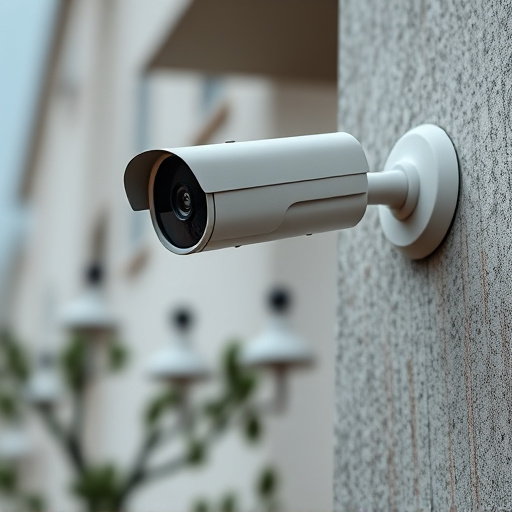The text discusses the strategic placement of fake security cameras (decoys) as a psychological deterrent against crime. By strategically positioning these realistic-looking devices in blind spots and high-risk areas like entry points, corners, and dark alleys, potential intruders are convinced they're under constant surveillance, thus reducing criminal activity. Best practices include integrating cameras into surroundings, using lighting to enhance their effectiveness, placing them in visible yet subtle locations with multiple angles, and ensuring adequate illumination without disturbing neighbors.
“Uncover the power of deception with our guide to fake security cameras, a strategic addition to any property’s defense. These innovative devices offer a subtle yet potent deterrent against potential intruders. By understanding their benefits and choosing the right shell design with integrated lights, you can enhance your home or business’s security without compromising aesthetics. Discover the key factors for optimal placement to maximize their effectiveness, ensuring peace of mind in today’s digital era.”
- Understanding Fake Security Cameras and Their Benefits
- Key Factors to Consider for Best Placement
- Choosing the Right Shell Design with Integrated Lights
- Installation Tips for Optimal Deterrence and Aesthetics
Understanding Fake Security Cameras and Their Benefits
Fake security cameras, also known as decoy or mockup cameras, are an innovative way to deter crime and enhance home or business security without the need for extensive surveillance systems. These realistic-looking devices mimic the appearance of genuine security cameras, but they do not capture any actual footage or data. Understanding the benefits of fake security cameras is essential, especially when considering their best placement strategies.
One of the primary advantages is their ability to act as a powerful psychological deterrent. By strategically placing these decoy cameras in visible areas, potential intruders are misled into believing that they are constantly under surveillance. This perception can significantly reduce the likelihood of criminal activity, as thieves and vandals may opt for easier targets. The best placement for fake security cameras is often near entry points like doors, windows, or parking areas, where their presence can be most impactful and noticeable to would-be intruders.
Key Factors to Consider for Best Placement
When determining the best placement for fake security cameras, or decoys, there are several key factors to consider. First and foremost, understand your property’s layout and blind spots. Identify areas where real cameras might be missing, such as corners or dark alleys, and strategically place decoys to fill these gaps. The goal is to create the illusion of a comprehensive surveillance system, deterring potential intruders.
Another crucial aspect is natural integration. Ensure the fake cameras blend seamlessly with their surroundings, whether it’s mounting them on existing structures like walls or trees, or using realistic designs that mimic genuine security equipment. Additionally, consider lighting options—well-placed lights can enhance the effectiveness of decoys by illuminating potential entry points and making it harder for intruders to remain unnoticed.
Choosing the Right Shell Design with Integrated Lights
When selecting a security camera shell with integrated lights, it’s crucial to consider the best placement for fake security cameras. The design should blend seamlessly into your environment, fooling potential intruders into believing genuine surveillance equipment is in use. Opt for shells that mimic the look and feel of real cameras, complete with realistic details like lenses and LED lights that replicate the appearance of a working camera.
The placement of these dummy cameras matters greatly. High-traffic areas like front doors, windows, and entry points are ideal locations as they serve as visible deterrents to would-be intruders. Ensure the shell design you choose allows for easy mounting at these best placement points, enhancing the overall security of your property while maintaining a subtle aesthetic.
Installation Tips for Optimal Deterrence and Aesthetics
For optimal deterrence, placement is key when it comes to fake security cameras. The best location for these decoys is in highly visible areas that offer a clear view of vulnerable points. Position them near entryways, windows, or any potential access points. A common strategy is to place them at angles, giving the appearance of multiple camera views. This tactic discourages would-be intruders as they’ll struggle to know if they’re being watched from different directions.
When it comes to aesthetics, consider your property’s architecture and surroundings. Match the style of the fake cameras to complement existing security measures for a seamless look. Ensure the lights are functional, providing adequate illumination without causing excessive glare or disturbing neighbors. Aim for a balanced blend of realism and subtlety; the goal is to create an environment where potential intruders feel observed, not alarm themselves with overly conspicuous surveillance.
Fake security cameras, when strategically placed (considering the best placement for fake security cameras), offer a cost-effective way to enhance home or business security. By choosing the right shell design with integrated lights and installing them thoughtfully, you can create an environment that deters crime while maintaining aesthetically pleasing surroundings. Remember, proper placement and realistic appearance are key to making these devices effective tools in your security arsenal.
